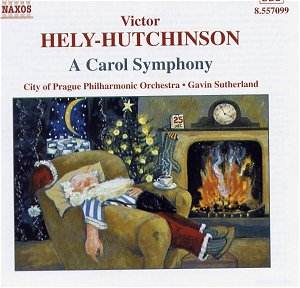I once told a friend that
I hadn’t bought him the disc of Christmas
music that he asked for because he could really
only play it once a year to which he replied,
"at least you can play it that often".
I know what he means. Anyway this disc can
be enjoyed throughout the winter and no one
should be ashamed of Christmas music in late
January, after all Cathedrals seem to keep
their trees up until Candlemass (February
2nd)!
Two composers use these melodies
in a symphonic way and although Bryan Kelly
‘Improvisations’ is not so structured,
neither are they a pot-pourri. At twelve minutes
his piece, which opens the disc, is an ideal
length for an amateur orchestra at its Christmas
Concert, although it was originally written
for the BBC Concert Orchestra. It proves itself
to be more of a suite by being in five movements
each on a different tune; for instance the
slow movement uses ‘Past three o’clock’.
The great joy for me was
to find, that Patric Standford’s ‘A
Christmas Carol Symphony’ has at last been
recorded. Originally broadcast (without its
Scherzo for some reason) in the early 1980s,
I promptly got the score. Each of the four
movements uses a range of tunes. The first,
in sonata form, takes ‘Deck the Halls’ as
a first subject and then plays with ‘Ding
Dong Merrily’ as a second with a third subject
‘God rest ye merry Gentleman’. This, traditional,
modal melody is popular on this disc. Kelly
uses it as a canonic opening movement and
Hely-Hutchinson as the only melody in the
Scherzo of his symphony. Standford, a wondrous
orchestrator has, incidentally, made a few
alterations to the orchestration of his symphony
compared with the score, which I don’t always
find to be beneficial. For example the ‘We
three Kings’ quote (letter L) is now on the
flute instead of the more wistful solo violin.
What a pity too that the meno mosso marking
is less effective than one would like. Also
when ‘I saw three ships’ makes its first appearance
in the violins, (letter J) the recorded balance
favours the brass too much, as it tends to
in other places, and the melody is drowned.
Or again has the orchestration altered? Despite
these reservations this is a fine work.
Hely-Hutchinson’s
Symphony, unlike Standford’s, has been recorded
many times before, and here it gets a crisp
and clear reading and recording. The opening
movement uses a lively counter-melody in the
strings above the brass, ‘Adeste Fidelis’
acting like a chorale. This is very nicely
done with beautifully defined dynamics and
subtle tempo alterations. It is amazing to
think that the composer was only 26 when he
composed and orchestrated this attractive
work.
Philip Lane is something
of a doyen of British light music. Interestingly
he was only 23 when he completed his colourful
but arguably a little too succinct ‘Wassail
Dances’ for the Gloucestershire Youth Orchestra.
The piece ends with a Gloucestershire melody
and also has one each from Yorkshire and Somerset.
These tunes are not so well known but the
middle movement, from Yorkshire, uses the
‘Here we come a-wassailing’ melody which you
will probably recognize. Lane is also responsible
for the tasteful arrangement for strings of
Peter Warlock’s beautiful and melancholy Carol-Anthem
‘Bethlehem Down’ which is nicely placed in
the middle of the CD.
Those readers who have a
particular penchant for this type of repertoire
will already feel that they owe Gavin Sutherland
a considerable debt of gratitude in his rediscovery
of light music gems in the ASV British Light
Music series. The City of Prague Philharmonic
are not only highly competent but seem to
revel in these pieces. I’m only sorry therefore
that you won’t read this until the festive
season 2002/3 is well and truly over. However
I would recommend that you buy it anyway in
preparation for next Advent and then have
it on your car CD player. It will offer you
considerable fun.
Useful notes and excellent,
seemingly well-prepared performances.
Gary Higginson
see also review
by Neil Horner
